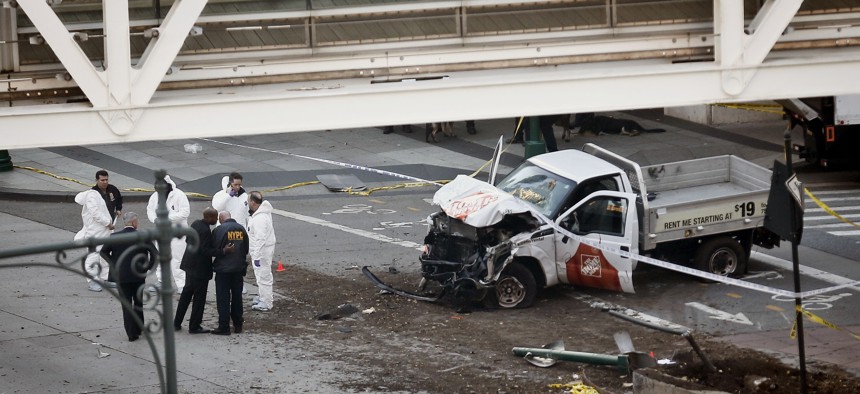
Authorities stand near a damaged Home Depot truck after a motorist drove onto a bike path near the World Trade Center memorial, striking and killing several people Tuesday, Oct. 31, 2017, in New York. Bebeto Matthews/AP
3 Cities Making Downtowns Safe from Vehicle Attacks
After the truck attack in Manhattan, there’s no excuse for a limited imagination when it comes to safer streets.
How do you stop a terrorist, a crazy person, or just a rage-filled asshole in a commercial vehicle from ramming into a sea of people ? Don’t bother: According to the Los Angeles Times, it’s near impossible.
“New York truck attack was predictable, just not preventable,” reads the headline of an article from Tuesday outlining the challenges of identifying malevolent intent among truck renters, after a driver plowed into a crowded Manhattan bike path on Tuesday, killing eight people.
“If somebody has a valid driver’s license and they’re not on any kind of watch list, it is very, very difficult to prevent them from renting a vehicle and conducting a lone wolf attack,’’ said Jake Jacoby, president of the Truck Renting and Leasing Association.
But hang on, that doesn’t make events like Tuesday’s inevitable. The article briefly acknowledges the protective role that bollards—those hitherto unsung heavyweight stanchions—can play in stopping vehicles should they try to invade pedestrian space. But nowhere does it consider the possibility that cars should be banned in areas where driving can inflict this much harm, as advocates, policy analysts, and journalists (including myself) have suggested.
It’s a pretty simple idea, but it’s not mysterious why car-free zones wouldn’t occur to everyone. Cars are the organizing principle of virtually every U.S. city. Driving is the default. Even people who don’t drive cars have to pay for roads. To rob a famous line from David Foster Wallace, this is water.
Yet it is entirely possible to eliminate certain vehicles from areas where they pose the greatest threat. Clarence Eckerson, the director of Streetfilms, has built a career in short documentaries of the world’s best practices in bike, walking, and transit planning. To help broaden car-oriented imaginations, he’s edited snippets from past videos highlighting European cities that have successfully blocked off large portions of their downtowns from single-occupancy vehicles. Two keys: rising bollards and strong political will.
Look at the success of Cambridge, UK, where bikes and feet rule the road. A cordon of bollards lift and lower only for public buses:
The Dutch city of Nijmegen, where bikes make up a whopping 60 percent of inner-city trips, has installed a similar system for its expansive car-free zone. Businesses were initially concerned about deliveries having access, so the city made sure to grant delivery trucks special transponders that communicate with the mobile barriers. Paul Van Den Anker, a city policy advisor, said: “With bollards, it’s simple. You can’t get in if you don’t have permission to get in.”
EXCLUSIVE @Streetfilms snippet. See how one city keeps cyclists & peds safe. Rising bollards. Typical all over Europe in car-free spaces pic.twitter.com/iv20wcKMtD
— Streetfilms (@Streetfilms) November 2, 2017
Of course, the Dutch determination to fend off motor vehicles is famously unrivaled. But check out Oslo, Norway, where biking’s mode share is lower than many major U.S. cities. The city has staked a path for an (almost) car-free center by 2019. They’re not quite at the bollard phase yet, but in some ways that’s more instructive: block by block, the city is starting to scrape out parking spaces and broadening bike lanes to build a people-first downtown.
Not all Norwegians are thrilled about this, by the way. But elected leaders have decided it’s in the public’s best interest, and with the support of the majority, they’re working with opponents to build a plan. Admittedly, in the U.S., that is kind of hard to imagine.




